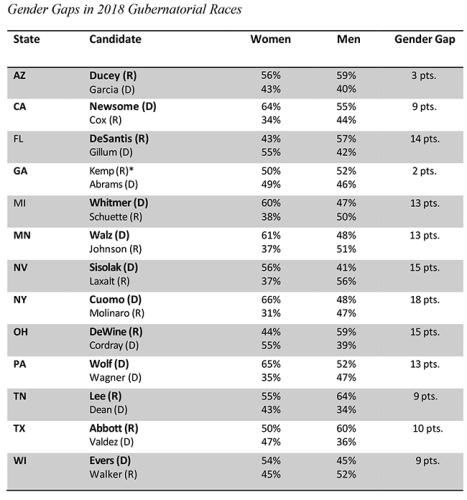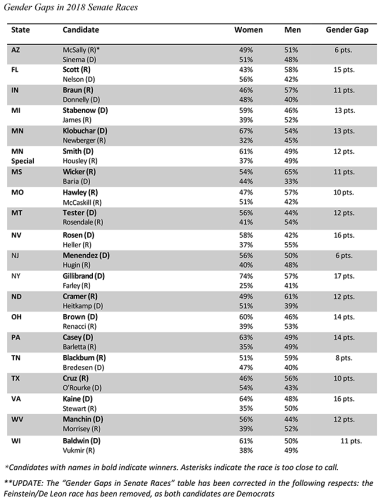Contact: Daniel De Simone; 760.703.0948
Election Day polls suggest that the preferences of women voters fueled the Democratic takeover of the U.S. House in the 2018 midterm elections. A sizable majority of women, 59%, compared with a minority of men, 47%, reported casting ballots for the Democratic congressional candidate in their district, according to the national exit poll conducted by Edison Research. This 12 percentage-point difference in the proportions of women and men voting for Democratic House candidates is larger than the 6-point and 10-point gender gaps evident in voting for the U. S. House in the 2010 and 2014 midterm elections, respectively.
Moreover, women’s preference for Democratic congressional candidates over their Republican opponents was stronger in 2018 than in previous midterm elections. According to Edison Research exit polls, 59% of women opted for the Democratic House candidate in 2018, compared with only 48% of women in 2010 and 51% in 2014.
In addition, the new election survey, referred to as VoteCast by the Associated Press (AP), and conducted jointly by the AP, Fox News, and the NORC, showed a similar pattern of gender differences in U.S. House voting in 2018, with 55% of women, compared with 45% of men, preferring the Democratic candidate in their district.
Susan J. Carroll, senior scholar at CAWP, suggested, “Although women’s votes have influenced election outcomes for many years, the role of women voters in 2018 has been more consequential than in any previous midterm election. Their unprecedented support for Democratic candidates is in large part responsible for the shift in control of the U.S. House, and women voters have joined participants in the Women’s March, Me Too activists, and this year’s record number of women candidates in helping reshape the contours of the current political landscape.”
Demographics and the Women's Vote
Several demographic groups of women were critical to Democratic victories in U.S. House races, including Black women, Latinas, and college-educated white women. Women of color voted heavily Democratic, with 92% of Black women and 73% of Latinas casting their ballots for Democratic House candidates.
White college-educated women also weighed in heavily for Democrats, with 59% voting for Democratic House candidates (compared with 42% of white women without college degrees). In contrast, in the 2016 elections white college-educated women split their votes evenly between Democrats and Republicans seeking U.S. House seats, with 49% opting for the Democratic candidate in their district and 49% opting for the Republican candidate, suggesting that white college-educated women have become more Democratic over the past two years. (White college-educated men, it should be noted, have also become more Democratic in their choices, with 47% voting for Democratic House candidates in 2018, compared with 38% in 2016; however, in contrast to highly educated women, more white college-educated men, 51%, voted for Republican House candidates in 2018 than for Democratic House candidates.)
The Gender Gap in Statewide Races
A gender gap in voting--defined as the difference in the proportions of women and men who voted for the winning candidate--also was evident in most of the U.S. Senate and gubernatorial races where exit polls were conducted by Edison Research, with women more likely than men to support the Democratic candidate and less likely to support the Republican candidate. Gender gaps ranging from 6 to 17 percentage points were apparent in all but one of the 21 US Senate races where exit polls were conducted. Similarly, gender gaps of 9 to 15 points were evident in nine of the 11 gubernatorial races.
In some of the high-profile statewide races where Democratic candidates lost, they nevertheless were supported by majorities of women voters. For example, Andrew Gillum, who was narrowly defeated in the Florida gubernatorial contest, won 55% of women’s votes. Similarly, losing U.S. Senate candidate Beto O’Rourke of Texas was backed by 54% of women voters.
Democratic women’s candidacies were buoyed by the votes of women. For example, Michigan gubernatorial candidate Gretchen Whitmer received 60% of women’s votes, compared with only 47% of men’s, propelling her to victory. Similarly, Nevada’s newly elected U.S. senator, Jacky Rosen, was supported by 58% of women voters but only 42% of men. Two incumbent Democratic women senators, Heidi Heitkamp of South Dakota and Claire McCaskill of Missouri, lost their races despite the fact that women preferred them to their male opponents.
Tables are attached to this release. They show gender differences in voting, with data drawn from the Edison Research exit polls.


Contact: Daniel De Simone; 760.703.0948

